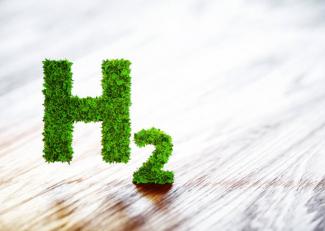NETL expertise was showcased at a recent workshop held to develop innovative pathways to produce hydrogen as a clean and affordable fuel of the future and identify opportunities for collaborative research efforts among national labs, academic researchers and industry partners.
Researchers from NETL, the National Renewable Energy Laboratory (NREL) and the Lawrence Livermore National Laboratory met with industry and academic representatives on June 22-23 at the NREL campus in Golden, Colorado, to discuss pathways to carbon-negative hydrogen production.
“As we work to mitigate the impact of climate change, it’s crucial that we identify how we can best interact to unlock the potential of hydrogen by developing carbon-negative hydrogen technologies and systems,” said NETL researcher Jonathan Lekse, a member of the event’s organizing committee.
While hydrogen is the simplest element in the universe, it doesn’t typically exist by itself in nature and must be produced from compounds that contain it. The most common way of producing hydrogen today is natural gas steam reforming, which requires high temperatures so that steam reacts with the hydrocarbon fuel to produce hydrogen. The process remains energy intensive and emits carbon dioxide (CO2), a greenhouse gas.
Nathan Weiland, a senior fellow at NETL, outlined analyses performed by NETL to support alternate methods of producing carbon-neutral or carbon-negative hydrogen.
He also explained how the research is aligned with the U.S. Department of Energy’s Hydrogen Shot, an initiative launched in June 2021 to reduce the cost of clean hydrogen by 80% to $1 per 1 kilogram in 1 decade (“1 1 1”) as well as the newly announced Clean Fuels & Products Shot, which aims to reduce greenhouse gas emissions from the fuel and chemical industry at least 85% by 2035. These DOE Energy Earthshot initiatives are key components to meeting the Biden–Harris Administration’s goal of net-zero carbon emissions by 2050.
In a presentation titled “Systems Analysis on Biomass Gasification to Carbon-Negative Hydrogen,” Weiland explained how NETL and its research partners are exploring ways to diversify gasifier feedstocks using biomass — a broad term to describe wood, food crops, grass, woody plants and other organic materials.
Gasification is a thermal process that uses chemical reactions to break down carbon-based materials into molecular building blocks, creating syngas, a product primarily consisting of carbon monoxide and hydrogen molecules. Traditionally, gasifiers have relied on coal and petroleum coke as feedstocks, but advances in co-gasification and integrated carbon capture technologies can enable hydrogen production with net-zero or net-negative CO2 emissions potential by blending biomass into the feedstocks.
“Advances in gasification of blended and variable feedstocks may enable co-gasification technology to perform reliably and flexibly to produce reliable and affordable supplies of hydrogen in a net-zero carbon emissions future,” Weiland said.
In addition, Weiland explained NETL’s intramural research efforts are investigating gasification of other waste feedstocks, such as construction demolition waste and municipal solid waste as well as reforming of renewable natural gas from landfills for carbon-negative hydrogen generation.
“These and other projects are especially important to establish a hydrogen economy and reap the many benefits it will provide,” Weiland said.
For instance, when used in fuel cells, hydrogen can power buildings, cars, trucks, portable electronic devices and backup power systems. Hydrogen is also envisioned as a long-duration energy storage medium to offset daily to seasonal differences between power generation and consumption. Furthermore, hydrogen is expected to be the most economic option for reducing the carbon footprint of difficult-to-decarbonize heavy industries such as iron/steel, chemicals and others requiring high temperature processes.
Other conference attendees shared updates on the development of electrochemical pathways, thermochemical pathways and biological and hybrid pathways to produce hydrogen.
NETL is a U.S. Department of Energy national laboratory that drives innovation and delivers technological solutions for an environmentally sustainable and prosperous energy future. By leveraging its world-class talent and research facilities, NETL is ensuring affordable, abundant and reliable energy that drives a robust economy and national security, while developing technologies to manage carbon across the full life cycle, enabling environmental sustainability for all Americans.




